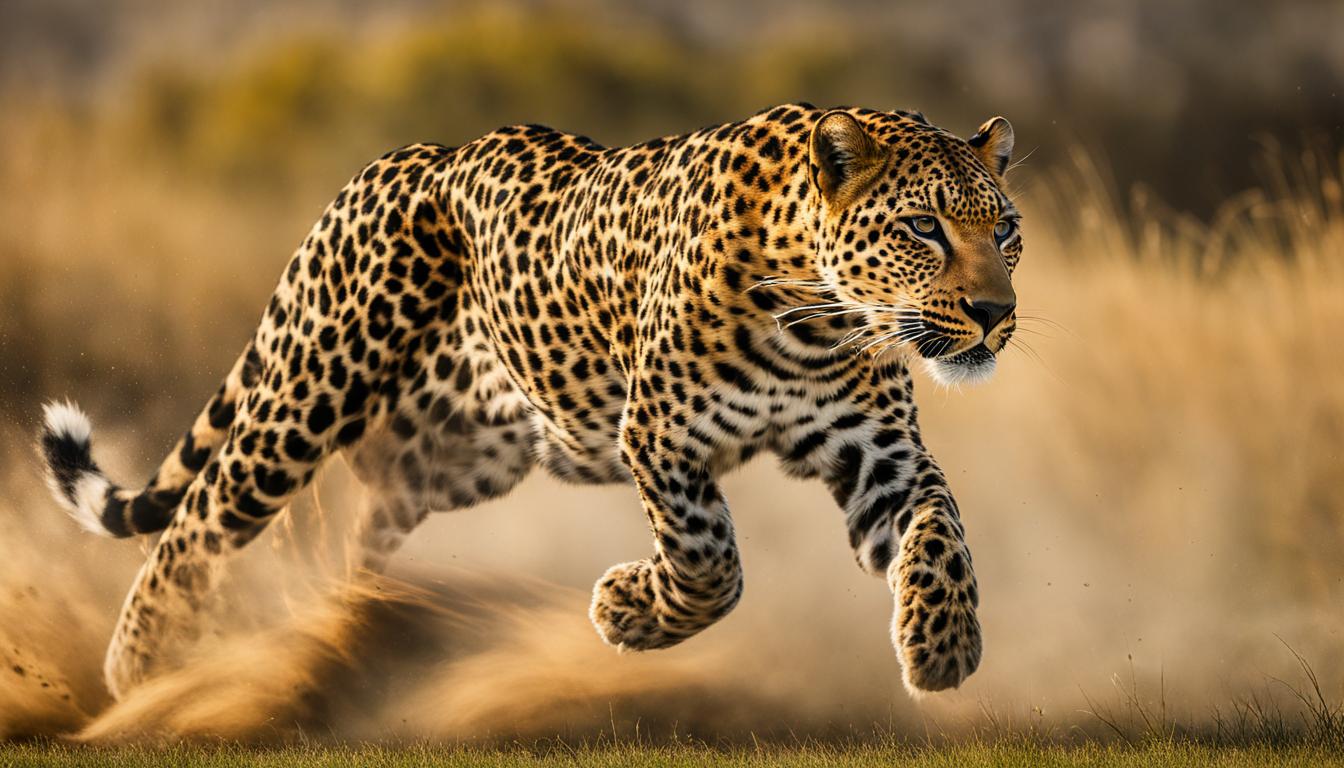Welcome to our article about the impressive speed and agility of leopards, one of the most swift predators in the animal kingdom. In this section, we will explore the leopard’s running speed, top speed, and overall agility. Get ready to be amazed by these agile big cats!
Leopards are known for their remarkable speed and agility. They can reach speeds of up to 58 kilometers per hour (36 mph) during short bursts of running. Their long, muscular legs allow them to cover large distances quickly, making them swift predators in the wild.
Not only are they fast, but leopards are incredibly agile as well. They possess the ability to climb trees, jump from branch to branch, and navigate difficult terrains with precision and speed. This agility makes them highly effective hunters, capable of chasing down their prey with ease.
Join us as we delve deeper into the fascinating world of leopards and uncover more about their remarkable speed and agility.
The Adaptability of Leopards
Leopards are highly adaptable creatures that possess a remarkable ability to adjust their hunting strategies based on the availability of prey in their environment. This adaptability allows them to thrive in various habitats and ensures their survival.
When prey is scarce, leopards have been known to hunt more frequently at night and target smaller animals, such as rodents and birds. Their stealth and agility enable them to navigate the darkness with precision, making them formidable predators under the cover of night.
On the other hand, in areas with a higher concentration of large prey, such as antelopes and zebras, leopards adapt their hunting patterns accordingly. They may hunt during the day, utilizing their speed and strength to take down these larger animals.
The adaptability of leopards not only allows them to sustain themselves but also contributes to the balance of ecosystems. By adjusting their strategies based on prey availability, they help control the population of certain species and maintain the health of their ecosystems.
Table: Prey Availability and Leopard Hunting Strategies
| Prey Availability | Hunting Strategy |
|---|---|
| Scarce | Nocturnal hunting and targeting smaller prey |
| Abundant | Diurnal hunting and focusing on larger prey |
As shown in the table above, leopards’ adaptability is reflected in their hunting strategies, ensuring their survival in different environments and contributing to the biodiversity of the animal kingdom.
Leopards’ Incredible Climbing Skills
Leopards are known for their incredible climbing skills, making them highly versatile hunters. With their strong limbs and gripping claws, they can easily scale trees, navigate branches, and leap from one tree to another with speed and agility. Their climbing abilities not only help them escape danger but also enable them to store their prey in the safety of the treetops.
When hunting, leopards often use trees as vantage points, allowing them to survey their surroundings and plan their next move. This strategic advantage enables them to ambush their prey from above, increasing their chances of a successful hunt. By utilizing their agility in trees, leopards can stealthily approach their prey and execute precise and powerful leaps to catch them off guard.
Furthermore, climbing trees serves as a means of protecting their kills from other predators. By hoisting their prey up into the branches, leopards can keep them out of reach of scavengers such as hyenas and lions. This behavior ensures that leopards can enjoy their meal undisturbed and conserves energy by preventing the need for repeated hunts.
The Importance of Tree Climbing for Leopards
The ability to climb trees is an essential skill for leopards, particularly in habitats with dense vegetation or uneven terrain. By exploiting this unique adaptation, leopards can access new hunting grounds and expand their territory. It also allows them to avoid confrontations with larger predators, seek refuge from potential threats, and protect themselves during encounters with other territorial individuals. The exceptional climbing abilities of leopards contribute significantly to their overall success as swift and elusive predators.
| Advantages of Leopards’ Climbing Skills | Disadvantages of Leopards’ Climbing Skills |
|---|---|
|
|
The Speed and Agility of Amur Leopards
Amur leopards, a subspecies of leopard, are known for their exceptional speed and agility. These magnificent creatures can reach speeds of almost 37 miles per hour (58 km/h), allowing them to swiftly chase down prey and escape potential threats. Their powerful leg muscles and elongated body give them the ability to cover long distances in a short amount of time, making them efficient hunters in their temperate forest habitats.
Not only are Amur leopards incredibly fast, but they are also highly agile. They possess the remarkable ability to leap horizontally up to 20 feet and vertically up to 10 feet. This agility allows them to navigate through dense vegetation, jump across obstacles, and climb trees with ease. Their flexible bodies and strong limbs enable them to move gracefully and swiftly, giving them a distinct advantage in their pursuit of prey.
“Amur leopards are unparalleled in their speed and agility, making them formidable predators in their natural habitat.” – Wildlife expert
The Physical Abilities of Amur Leopards
The physical abilities of Amur leopards extend beyond their running speed and agility. They are also excellent swimmers, capable of crossing rivers and navigating through water effortlessly. This versatility allows them to access different areas of their habitat and expand their hunting grounds.
The combination of their remarkable speed, agility, and swimming abilities showcases the incredible physical prowess of Amur leopards. These adaptations have allowed them to thrive in their unique environment and establish themselves as one of the most impressive predators in the animal kingdom.

| Physical Abilities | Description |
|---|---|
| Running Speed | Almost 37 mph (58 km/h) |
| Horizontal Leap | Up to 20 feet |
| Vertical Leap | Up to 10 feet |
| Swimming Ability | Excellent |
Why Are Amur Leopards Endangered?
Amur leopards are facing a multitude of threats that have pushed them to the brink of extinction. One of the main factors contributing to their endangerment is habitat loss. Logging, forest fires, and the conversion of forests for agriculture have significantly reduced the available habitat for these magnificent creatures. As their natural habitat diminishes, so does their ability to find food and establish territories, further endangering their survival.
Poaching is another major threat to the Amur leopards. The demand for their fur in the illegal wildlife trade is high, leading to increased hunting and trapping of these beautiful animals. The low number of Amur leopards left makes them even more vulnerable to poaching, as their small population size makes them easier targets.
“The continued existence of wildlife and wilderness is important to the quality of life of humans.”
In addition to habitat loss and poaching, low genetic variation poses a significant risk to the Amur leopards. With a small population size, inbreeding becomes a concern, leading to a decrease in genetic diversity. This lack of genetic variation makes the leopards more susceptible to diseases and reduces their ability to adapt to changing environmental conditions, further jeopardizing their chances of survival.
The Impact of Conservation Efforts
Conservation efforts aimed at protecting the Amur leopards and their habitats are crucial in ensuring their survival. By raising awareness about their endangered status and implementing measures to combat habitat loss and poaching, conservation organizations and governments can make a significant difference in preserving these majestic creatures.
By taking action to protect the Amur leopards, we not only safeguard their existence but also contribute to the conservation of the entire ecosystem. The preservation of their habitats ensures the survival of other wildlife species that depend on these habitats, promoting biodiversity and maintaining the delicate balance of nature.
Awareness and Action
It is essential for individuals to be aware of the threats facing Amur leopards and take action to protect them. Supporting conservation organizations financially, raising awareness through education and advocacy, and promoting sustainable practices are all ways that individuals can contribute to the preservation of these incredible animals.
Together, we can make a difference in the fight to save the Amur leopards from extinction. By acknowledging the importance of their conservation and taking proactive steps to address the challenges they face, we can ensure a future where these beautiful creatures continue to roam their natural habitats, captivating us with their speed, agility, and beauty.
Impact of Amur Leopard Conservation
Conservation efforts for Amur leopards have a significant impact on the entire ecosystem. By protecting these magnificent big cats, we are also preserving the delicate balance of their natural habitat. The Amur leopard ecosystem consists of various interconnected species, with each playing a vital role in maintaining the overall health and biodiversity of the region.
One of the key benefits of conserving Amur leopards is the protection of their prey species. These include animals like roe deer, sika deer, and hares. By safeguarding the leopards, we ensure the survival of their prey, creating a sustainable environment for these species to thrive. This, in turn, has a positive cascading effect on other predators such as Amur tigers, which rely on a healthy prey population for their own survival.
| Impact of Amur Leopard Conservation | How it Benefits the Ecosystem |
|---|---|
| Protecting Amur leopards | Preserves the delicate balance of the ecosystem |
| Preserving prey species | Ensures the sustainability of the food chain and supports other predators |
| Safeguarding their habitat | Maintains the overall health of the ecosystem and its biodiversity |
The conservation efforts also extend to protecting the habitat of Amur leopards. This involves maintaining and restoring their natural surroundings, including the temperate forests and grasslands they call home. By preserving their habitat, we provide a safe haven for these magnificent creatures to thrive, while also protecting the countless other species that rely on this ecosystem for survival.
Conservation Efforts are Essential for the Future
Conserving Amur leopards and their ecosystem is not only crucial for the survival of these endangered big cats, but it is also vital for the future of our planet. These conservation efforts help to maintain biodiversity, ensure the balance of ecosystems, and contribute to the overall health of our natural world. It is our collective responsibility to support and actively participate in these efforts, protecting the Amur leopard and the incredible ecosystem it inhabits for generations to come.

Taking Action to Protect Amur Leopards
To ensure the survival of Amur leopards and protect them from illegal hunting, it is essential to take immediate action. Various conservation organizations are actively working to stop poaching and protect these magnificent creatures. By supporting these organizations, you can contribute to the preservation of Amur leopards and their habitats.
An important step in protecting Amur leopards is to donate to reputable conservation organizations such as the World Wildlife Fund and TRAFFIC. These organizations utilize funds to implement anti-poaching measures, conduct research, and raise awareness about the critical situation faced by Amur leopards. Your contribution can make a significant difference in the efforts to safeguard these endangered big cats.
In addition to financial support, another way to take action is to avoid purchasing products made from leopard skin or other animal products. The illegal trade of leopard fur contributes to the decline of Amur leopards and perpetuates the cycle of poaching. By refusing to buy these products, you can help reduce the demand and discourage the hunting of Amur leopards.
Furthermore, the establishment of protected areas plays a crucial role in the conservation of Amur leopards. Land of the Leopard National Park, for example, provides a safe haven for these endangered cats and their habitats. By promoting the creation of more protected areas, we can ensure the long-term survival of Amur leopards and preserve the biodiversity of their ecosystems.
Conclusion
Leopards possess incredible speed and agility, making them remarkable predators in the animal kingdom. Their ability to run at impressive speeds and navigate through challenging terrain with ease showcases their physical prowess. However, the survival of many leopard species, including the endangered Amur leopard, is under threat.
Conservation efforts play a vital role in protecting these magnificent creatures and preserving biodiversity. By supporting organizations like the World Wildlife Fund and TRAFFIC, you can contribute to the fight against illegal hunting and trade. Donating to these organizations helps safeguard the habitats of leopards and their prey, ensuring the balance of ecosystems.
Preserving biodiversity is essential for the overall health of our planet. Leopards are important contributors to the intricate web of life, and their extinction would have far-reaching consequences. By taking action and being conscious of our choices as consumers, we can make a significant impact on the conservation of these majestic big cats and the ecosystems they call home.
What is the difference in running speed and agility between leopards and cheetahs?
Leopards and cheetahs have distinct running abilities. Cheetah running speed explained – cheetahs can reach speeds of 70 mph in short bursts, making them the fastest land animal. On the other hand, leopards are more agile, able to change direction quickly. Each cat’s unique abilities are adapted to their hunting and survival needs.
FAQ
How fast can leopards run?
Leopards can reach speeds of up to 58 kilometers per hour (36 mph) during short bursts of running.
How agile are leopards?
Leopards are incredibly agile. They can climb trees, jump from branch to branch, and navigate difficult terrain with precision and speed.
How do leopards adapt their hunting strategies?
Leopards adjust their hunting strategies based on the availability of prey in their environment. In areas with scarce prey, they may hunt more at night or target smaller prey like rodents and birds. In areas with a higher concentration of large prey, they may hunt during the day and focus on larger animals.
Can leopards climb trees?
Yes, leopards are excellent climbers. They can easily scale trees to escape danger or to store their prey. They are known for their ability to run up tree trunks and jump from branch to branch with speed and agility.
How fast and agile are Amur leopards?
Amur leopards can run at speeds of almost 37 miles per hour (58 km/h), leap horizontally up to 20 feet, and vertically up to 10 feet. They are extremely agile animals.
Why are Amur leopards endangered?
Amur leopards are primarily endangered due to habitat loss and poaching. Logging, forest fires, and destruction of forests for agriculture have destroyed much of their original habitat. Poaching for their fur is another major threat. The low number of Amur leopards left makes them susceptible to diseases, and inbreeding due to the small population exacerbates these risks.
What is the impact of Amur leopard conservation?
Conservation efforts for Amur leopards have a positive impact on the entire ecosystem. By protecting the leopards, their prey species such as roe deer, sika deer, and hares are also preserved. This, in turn, helps other predators like Amur tigers. Conserving the habitat is crucial as it provides a safe and sustainable environment for the leopards and ensures the survival of the ecosystem as a whole.
How can we take action to protect Amur leopards?
It is illegal to commercially hunt and sell Amur leopards, and organizations such as the World Wildlife Fund and TRAFFIC are actively working to stop poaching and illegal trade. Donating to these organizations can support their conservation efforts. Additionally, the creation of protected areas like Land of the Leopard National Park has played a significant role in safeguarding Amur leopards and their habitats. Avoiding the purchase of products made from leopard skin or other animal products also helps protect these endangered creatures.










